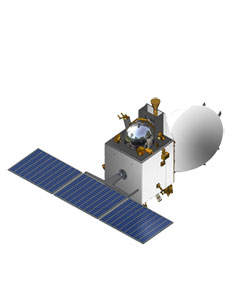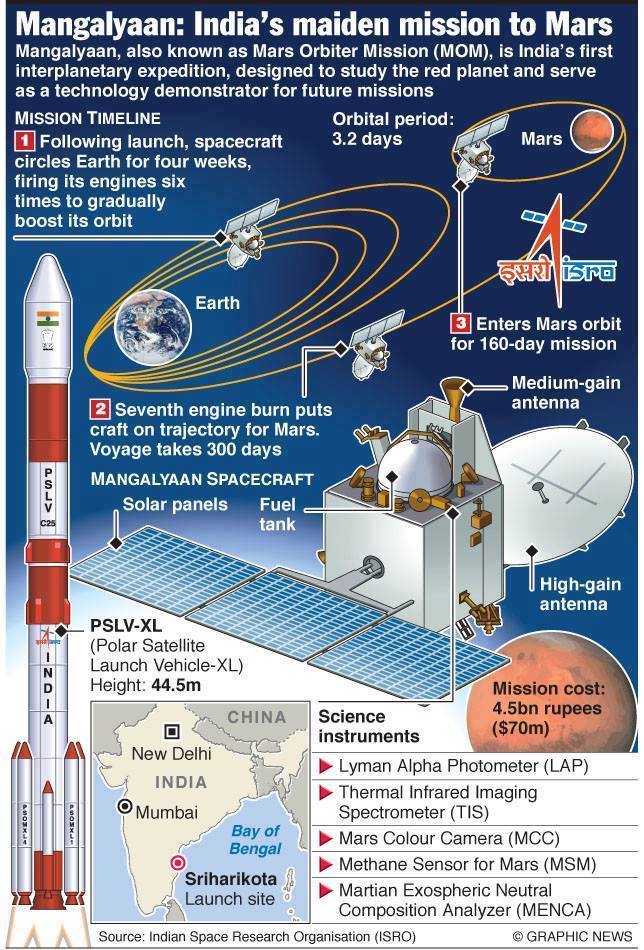 Mars Orbiter Mission (MOM), an inter planetary mission to planet Mars, has become a huge success with the satellite entering the designated MARS orbit, a few days back. Indian Prime Minister Mr. Narendra Modi himself witnessed the final orbital maneuvers and congratulated the ISRO and other scientists and engineers who contributed to the successful launch.
Mars Orbiter Mission (MOM), an inter planetary mission to planet Mars, has become a huge success with the satellite entering the designated MARS orbit, a few days back. Indian Prime Minister Mr. Narendra Modi himself witnessed the final orbital maneuvers and congratulated the ISRO and other scientists and engineers who contributed to the successful launch.
Indeed, the MOM experiment is a giant step forward for India. It is notable that India achieved the success on its first attempt itself whereas more advanced countries like, USA took several attempts before realizing the dream. It is widely acknowledged that the mission is very complex in nature, and it took about an year to achieve the feat.
The brief time table for the mission is given below:
It has been configured to carry out observation of physical features of mars and carry out limited study of Martian atmosphere with following five payloads:
- Mars Colour Camera (MCC)
- Thermal Infrared Imaging Spectrometer (TIS)
- Methane Sensor for Mars (MSM)
- Mars Exospheric Neutral Composition Analyser (MENCA)
- Lyman Alpha Photometer (LAP)
Various dimensions of the rocket used for the mission are as given below:
| Lift-off Mass | 1337 kg |
| Structures | Aluminum and Composite Fiber Reinforced Plastic (CFRP) sandwich construction-modified I-1 K Bus |
| Mechanism | Solar Panel Drive Mechanism (SPDM), Reflector & Solar panel deployment |
| Propulsion | Bi propellant system (MMH + N2O4) with additional safety and redundancy features for MOI. Proplellant mass:852 kg |
| Thermal System | Passive thermal control system |
| Power System | Single Solar Array-1.8m X 1.4 m – 3 panels – 840 W Generation (in Martian orbit), Battery:36AH Li-ion |
| Attitude and Orbit Control System | AOCE (Attitude and Orbit Control Electronics): with MAR31750 Processor
Sensors: Star sensor (2Nos), Solar Panel Sun Sensor (1No), Coarse Analogue Sun Sensor Actuators: Reaction Wheels (4Nos), Thrusters (8Nos), 440N Liquid Engine |
| Antennae: | Low Gain Antenna (LGA), Mid Gain Antenna (MGA) and High Gain Antenna (HGA) |
| Launch Date | Nov 05, 2013 |
| Launch Site | SDSC SHAR Centre, Sriharikota, India |
| Launch Vehicle | PSLV – C25 |
aa
image courtesy:
http://swapsushias.blogspot.in/2013/11/things-you-must-know-about-isro-mars.html#.VCgpsFJoFxA
Timeline:
| Phase | Date | Event | Detail | Result |
|---|---|---|---|---|
| Geocentric phase | 5 November 2013 09:08 UTC | Launch | Burn time: 15:35 min in 5 stages | Apogee: 23,550 km |
| 6 November 2013 19:47 UTC | Orbit raising manoeuvre | Burn time: 416 sec | Apogee: 23,550 km to 28,825 km | |
| 7 November 2013 20:48 UTC | Orbit raising manoeuvre | Burn time: 570.6 sec | Apogee: 28,825 km to 40,186 km | |
| 8 November 2013 20:40 UTC | Orbit raising manoeuvre | Burn time: 707 sec | Apogee: 40,186 km to 71,636 km | |
| 10 November 2013 20:36 UTC | Orbit raising manoeuvre | Incomplete burn | Apogee: 71,636 km to 78,276 km | |
| 11 November 2013 23:33 UTC | Orbit raising manoeuvre (supplementary) |
Burn time: 303.8 sec | Apogee: 78,276 km to 118,642 km | |
| 15 November 2013 19:57 UTC | Orbit raising manoeuvre | Burn time: 243.5 sec | Apogee: 118,642 km to 192,874 km | |
| 30 November 2013, 19:19 UTC | Trans-Mars injection | Burn time: 1328.89 sec | Successful heliocentric insertion | |
| Heliocentric phase | December 2013 – September 2014 | En route to Mars – The probe travelled a distance of 780,000,000 kilometres (480,000,000 mi) in a parabolic trajectory around the Sun to reach Mars This phase plan included up to four trajectory corrections if needed. | ||
| 11 December 2013 01:00 UTC | 1st Trajectory correction | Burn time: 40.5 sec | Success | |
| 9 April 2014 | 2nd Trajectory correction (planned) | Not required | Rescheduled for 11 June 2014 | |
| 11 June 2014 11:00 UTC | 2nd Trajectory correction | Burn time: 16 sec | Success | |
| August 2014 | 3rd Trajectory correction (planned) | Not require | ||
| 22 September 2014 | 3rd Trajectory correction | Burn time: 4 sec | Success | |
| Areocentric phase | 24 September 2014 | Mars orbit insertion | Burn time: 1388.67 sec | Success |

